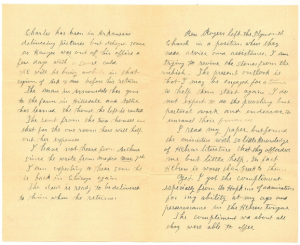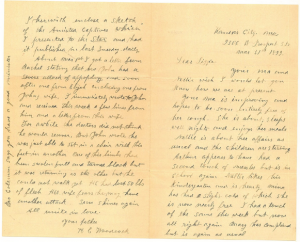Author: Henry E. Woodcock
Recipient: Elizabeth Woodcock
Date: 31 March 1899
Location: Henry Edwin Woodcock Papers, Record Group 30/81, Series 1. Correspondence, Oberlin College Archives
Document Type: Autograph Letter, Signed by the Author
Introduction:
In this letter to his oldest daughter, Lizzie, then about 44 years of age, Henry mostly discusses illnesses and deaths, but more importantly, he talks with his daughter about his work revitalizing a congregation and discusses the qualifications of some of his colleagues. This communication signifies that he not only respected his daughter, but treated her as equal enough to feel comfortable venting his feelings to her. In this letter, he also mentions a newspaper column he wrote on the Amistad Captives, an event which occurred from 1839 to 1841, a good 60 years prior to the writing of this letter, and is evidence of the Woodcocks’ long dedication to the both the cause of civil rights itself, and the history of abolition.
2306 N. Prospect St
Mar 31st 1899
Dear Lizzie,
Your Ma and Nellie1 wish I would let you know how we are at present.
Your Ma is improving and hopes to be soon entirely free of her cough. She is about, sleeps well nights and enjoys her meals.
Nellie is about her affairs as usual and the children are stirring. Arthur2 appears to have had a second touch of measles but is in school again. Walter3 likes his kindergarten and is hearty. Mina4 has had a slight cold of which she is now nearly free. I had a touch of the same this week but now all right again. Mary5 has complained but is again as usual.
Charles6 has been in Arkansaw delivering pictures but delayed some as Hanger7 was out of his office a few days with a severe cold.
 HE will be busy awhile in that region of Ark & Mo8 before his return.
HE will be busy awhile in that region of Ark & Mo8 before his return.
The man in Armourdale9 has gone to the farm in Hillsdale10 and Nellie has learned the house he left is rented.
The rent from the two houses and that for the one room here will help out her expenses.
I have not heard from Arthur11 since he wrote from Mexico Mar. 7th
I am expecting to hear soon he is back in Chicago again.
The deed is ready to be delivered to him when he returns.
[sic] Rev Rogers left the Plymouth Church12 in a position where they need advice and assistance. I am trying to revive the stones from the rubish [rubbish]. The present outlook is that I may be engaged for a time to help them start again. I do not expect to do the preaching but pastoral work and endeavor to unravel their finances.
I read my paper but found the ministers with so little knowledge of HEbrew [sic] literature that they afforded me but little help. In fact HEbrew is worse than Greek to them.
Yet I got the compliment especially from Dr Hopkins of admiration for my ability at my age and perseverance in the HEbrew tongue.
The compliment wa[s] about all they were able to offer.
I herewith enclose a sketch of the Amistad Captives13 which I presented to the Star14 and had it published in last Tuesday .[sic] daily
About Mar 1st I got a letter from Rachel15 stating that bro John16 had a severe attack of appoplexy [apoplexy] and soon after one from Elijah17 enclosing one from Johns wife.18 I immediately wrote to John and received this week a few lines from him and a letter from his wife.
For awhile the doctors did not think he would recover. But John wrote he was just able to sit in a chair with his feet in another. One of his limbs had been swolen [sic] full and turned black but it was returning as the other but he could not walk yet. HE had lost 50 lbs of flesh. HEs [his] wife fears he may have another attack. Sun shines again.
All unite in love.
Your father
H E Woodcock
[written on the bottom left side margin] Bro Coleman says you have a good minister
Transcribed by Mimi Stern.

Source: Oberlin College Archives, The Henry Edwin Woodcock Papers. Series 4. Miscellany, 1987/67. 1989/141. RG 30/81.
1Ellen (Nellie) Woodcock (b. 1857 d. 1935) was Elizabeth’s (Lizzie’s) sister and the daughter of Henry Woodcock and Lucy Thayer Woodcock (Oberlin College Archives, The Henry Edwin Woodcock Papers. 1987/67. 1989/141. RG 30/81).
2Nellie and Charles Green Upton’s first child (b. 1890), who was nine years old at the time of this letter (Oberlin College Archives, Henry Edwin Woodcock Papers, Series 4. Files Relating to the Woodcock Family).
3Walter Upton, the second of three of Nellie’s children, born in 1892 (Oberlin College Archives, Henry Edwin Woodcock Papers, Series 4. Files Relating to the Woodcock Family).
4Mina Upton, the third child of Nellie and Charles Green Upton, born in 1894 (Oberlin College Archives, Henry Edwin Woodcock Papers, Series 4. Files Relating to the Woodcock Family).
5Possibly Eliza Marie Jones’ daughter, Mary, born in 1835 (Oberlin College Archives, Henry Edwin Woodcock Papers, Series 2. Writings).
6Charles Green Upton, Nellie’s husband (b.1852, d. 1941)(Oberlin College Archives, Henry Edwin Woodcock Papers, Series 4. Files Relating to the Woodcock Family).
7Most likely Charles’ colleague or client.
8Arkansas and Missouri.
9Neighborhood in Kansas City, Missouri, founded in 1881 as part of the meatpacking district ( J’Nell Pate, America’s Historic Stockyards: Livestock Hotels (Fort Worth, TX: TCU Press, 2005), 83-132.
10Village in Missouri
11Arthur Woodcock Noble, Henry’s son from his first marriage. By this time, he was most likely married to Frances Woodward, and working as a lawyer in Chicago at her family’s firm (Oberlin College Archives, Henry Edwin Woodcock Papers, Series 4. Files Relating to the Woodcock Family).
12Church in Lawrence, Kansas, that Henry Woodcock helped revitalize. Possibly written as “Plymsmith.”
13The Amistad was a slave ship on a transit route from Sierra Leone to Havana, Cuba. In July of 1839, the slaves aboard mutinied and took control of the ship. The Amistad was soon taken into custody and interred in New Haven, Connecticut, where the fate of the former slaves became a source of great debate, with many abolitionists demanding that they be freed and given transport back to their homes in Africa, while others, including President Van Buren, favored returning them to Cuba and slavery. The subsequent court case, United States vs. The Amistad, reached the Supreme Court in 1841. It ruled that the Mende slaves had been illegally transported and held as slaves, and ordered them freed, but did not provide them with the means to return to Africa. The thirty-five surviving slaves were finally able to go home in 1842, with money from the United Missionary Society. Henry Woodcock’s editorial (which is included in the visuals for this collection) focused on the bigotry facing the former slaves, and the reluctance of the current United States Government to do what he felt was the moral thing by helping them return to Africa. He also notes the importance of missionary societies in aiding these slaves, and uses the fact that one of the Amistad captives then became a Christian Missionary herself, as proof of the power of Christianity to right the wrongs of the past and create a moral world. (National Archives. “Teaching with Documents: The Amistad Case, Background.” The National Archives Teachers’ Resources. Teaching With Documents. Expansion and Reform (1801-1861), web address, accessed 19 March 2015; Oberlin College Archives, Henry Edwin Woodcock Papers, Series 3. Miscellany).
14The Kansas City Star, a newspaper founded in 1880 (The Kansas City Star, about Us, our History. Informed by the Kansas City Star’s Centennial Edition, Sept. 14, 1980.” Kansas City Star, web address, accessed 19 March 2015).
15Henry’s sister Rachel Cline, b. 1820 (Oberlin College Archives, Henry Edwin Woodcock Papers, Series 2. Writings).
16John Quincy Adams Woodcock (b. 1824, d. 1914), Henry Woodcock’s brother. He was married first to Clarinda Sherwood (b. 1827, d. 1885) and then to Clementine, his wife at time of this letter (Oberlin College Archives, Henry Edwin Woodcock Papers, Series 2. Writings).
17Elijah Woodcock, brother of Henry Woodcock, b. 1832. He married Loretta Curtis (Oberlin College Archives, Henry Edwin Woodcock Papers, Series 2. Writings).
18Clementine (b. 1844, d. 1913). (Oberlin College Archives, Henry Edwin Woodcock Papers, Series 2. Writings).
